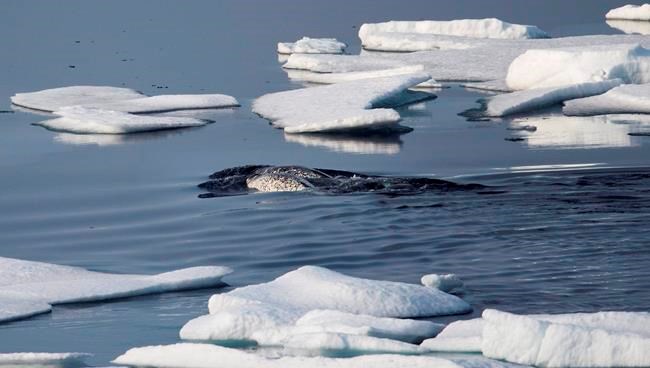A new report predicts there will be almost no narwhal left in an area off the northeastern coast of Baffin Island this summer and says shipping traffic from the nearby Mary River iron-ore mine is to blame.
Working groups from the North Atlantic Marine Mammal Commission and Canada/Greenland Joint Commission on Beluga and Narwhal met in Denmark in December and published their report this week, which the mine's operator says leaves out key information.
The report concludes that increased shipping traffic is "by far the most likely cause" of declining numbers of narwhal in Eclipse Sound, where they migrate from Baffin Bay each summer.
"Unless shipping is increasingly regulated, or narwhals adapt to the changes and reinhabit the abandoned areas, we may expect long-term population consequences that extend far beyond the currently observed lumping of narwhals," it said.
It adds it is highly unlikely the whales will return as long as there is continued disturbance in the area and it is impossible to rule out a worst-case scenario where the displaced narwhal could go extinct within 100 years.
Hunters in Pond Inlet, known as Mittimatalik in Inuktitut, have reported seeing fewer narwhal in areas where they were once abundant and the tusked whales' behaviour is changing, harming their ability to harvest the animals they rely on for food, livelihoods and culture.
They, along with marine conservation charity Oceans North, have also said it's due to increased shipping from the mine, which began operations in 2015.
“Narwhal moving out of the area where they have traditionally been hunted is devastating for Inuit and the ecosystem integrity of the region," the Mittimatalik Hunter and Trappers Organization wrote in a submission to the Nunavut Impact Review Board.
Aerial surveys conducted for Baffinland Iron Mines Corp., which owns the Mary River mine, have shown a decline in the number of narwhal in Eclipse Sound. A survey in 2021 estimated there were 2,595 in the area, down from 5,019 in 2020. Fisheries and Oceans Canada estimated there were more than 12,000 narwhal in Eclipse Sound in 2016, and more than 20,000 in 2004.
Baffinland has said factors other than shipping may have led to the drop in numbers including changing ice conditions and predator-prey dynamics, or natural migration to Admiralty Inlet, where the number of narwhal observed in the summer has increased.
But the report — which examined aerial surveys, results from a narwhal tagging program and a metapopulation model — concluded there's no evidence to suggest the displacement of narwhal from Eclipse Sound was caused by climate change or predators like killer whales.
“It is concluded that increased ship traffic is by far the most likely cause for the huge — almost complete — population displacement of narwhals from Eclipse Sound," the report states.
The report recommends further research including continued aerial surveys, tagging studies, and collecting tissue from harvested animals.
The company said it was not made aware of the workshop or invited to share its research with the working groups and questioned the report's findings.
"Baffinland has conducted the most extensive research in the region," spokesperson Peter Akman wrote in a statement.
Akman said Baffinland's monitoring program has shown the impact of passing ships on narwhal is localized and temporary. He added the company's shipping activities peaked in 2019, when the abundance of narwhal was found to be stable compared to estimated numbers in 2013 and 2016.
Akman said the working groups failed to consider the effect of other activities like pile driving associated with a small craft harbour in Pond Inlet, which he said created intense, high-impact noise during the 2020 shipping season.
The company takes several mitigation measures to reduce potential impacts from shipping on marine mammals, he said. They include a speed limit of nine knots for vessels and using ship convoys to reduce underwater sound. The company also agreed to not use icebreakers the past two shipping seasons in response to concerns from Inuit.
"Baffinland's marine monitoring program and marine-related mitigation measures are unparalleled in the industry," Akman wrote.
He said the company will continue to work with the Hamlet of Pond Inlet, Mittimatalik Hunter and Trappers Organization, Qikiqtani Inuit Association, federal and Nunavut governments and non-government environmental organizations to finalize its adaptive management response plan for 2023.
Since 2018, roughly six million tonnes of iron ore has been extracted from the Mary River mine every year and transported by ships from Milne Inlet.
Federal ministers rejected Baffinland's proposal to double annual production at the mine to 12 million tonnes of ore in November.
This report by The Canadian Press was first published Feb. 10, 2023.
This story was produced with the financial assistance of the Meta and Canadian Press News Fellowship.
Emily Blake, The Canadian Press



